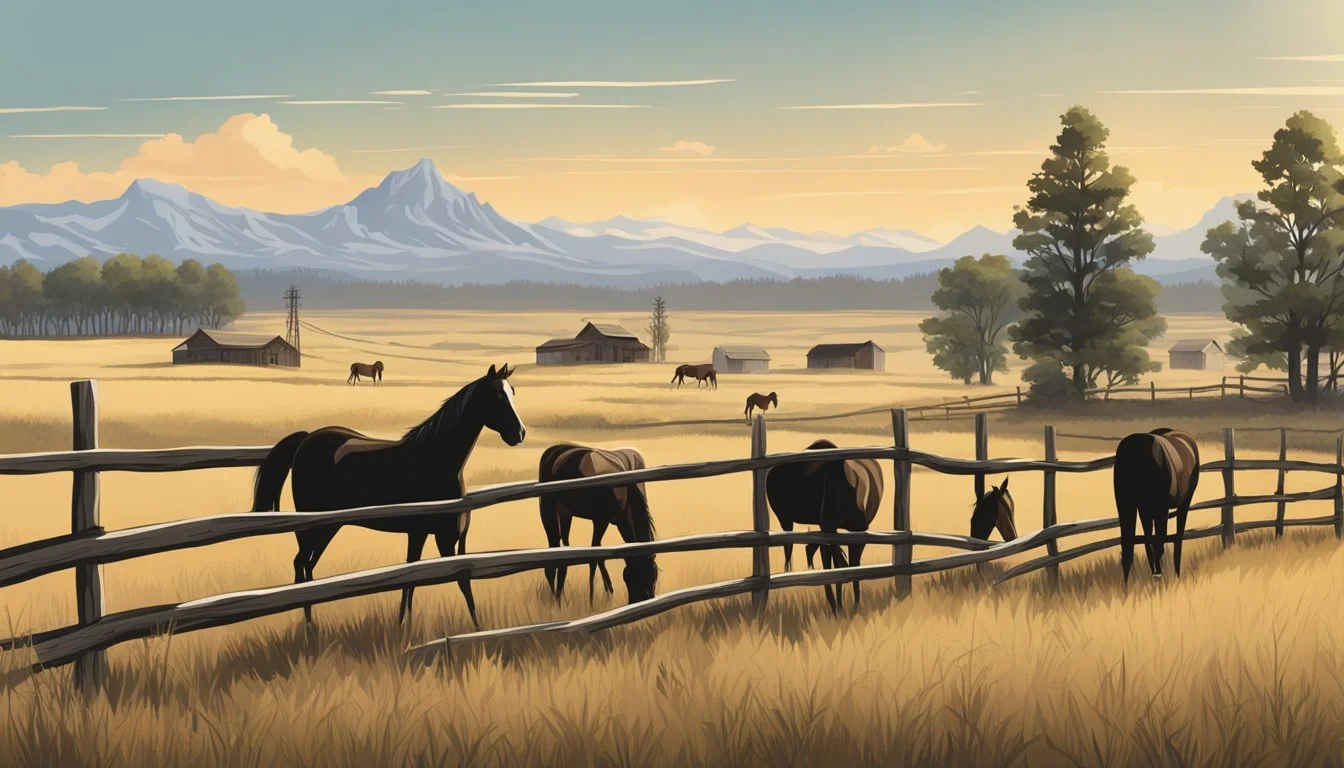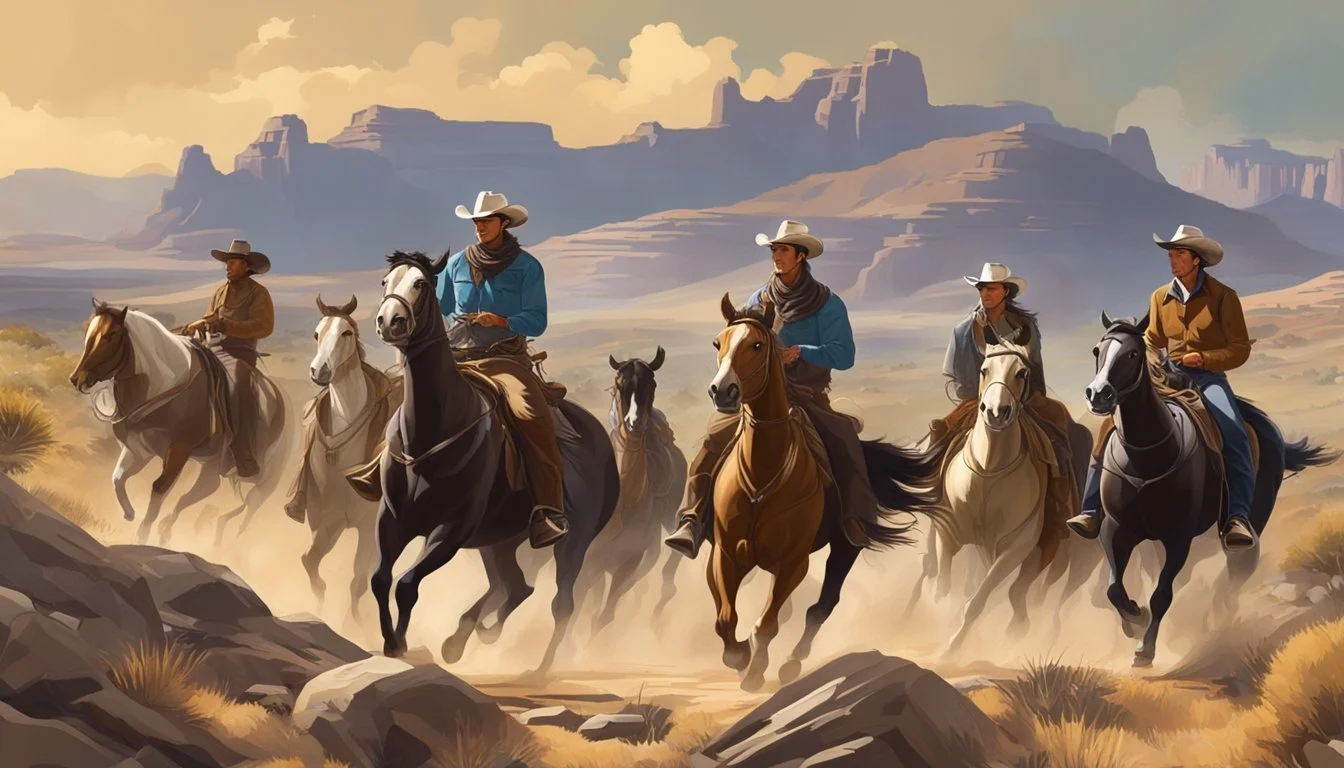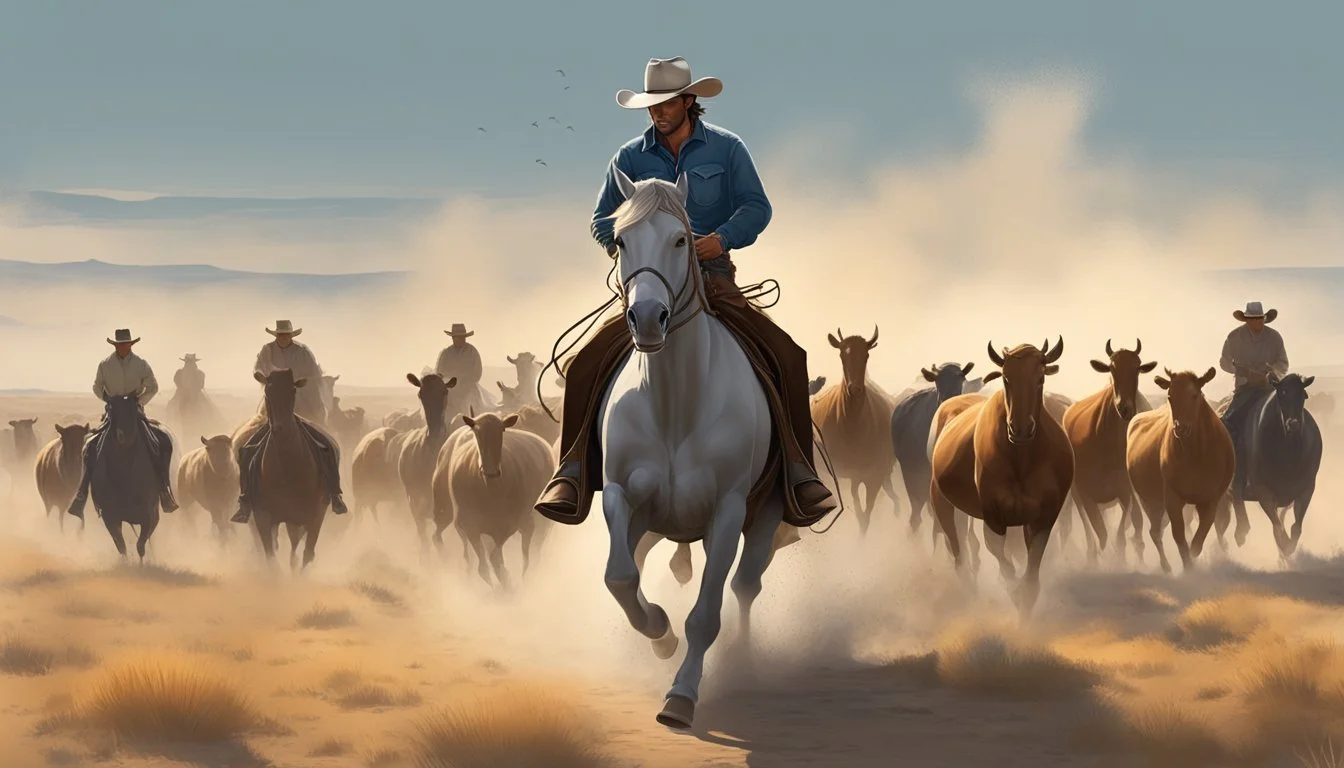The Role of Horses in Cowboy Culture
Bridging Past and Present Traditions
The role of horses in cowboy culture is deeply ingrained in the fabric of the American West, a relationship that has been pivotal in shaping not only the livelihood of the cowboys but also the heritage of an entire nation. Initially brought to the Americas by Spanish explorers, horses became the cornerstone of cowboy life, transforming how cowboys worked with cattle, traversed the vast landscapes, and even how they engaged in leisure. They symbolized freedom, strength, and the enduring spirit of the frontier, becoming as emblematic of the West as the cowboys themselves.
Cowboys, skilled horsemen who herded cattle across the open plains, depended greatly on their equine partners. Their horses were not only a means of transportation but also co-workers in the rigorous tasks associated with managing livestock. The unique demands of the rugged terrain and the necessity of managing herds over large expanses of land led to the development of specialized breeds, such as the American Quarter Horse, renowned for its speed and agility. These horses were instrumental in the daily life of a cowboy, contributing to both their efficiency and their safety.
Today, while technology and modern methods have transformed many aspects of cowboy culture, the bond between cowboy and horse remains a central element of its identity. Horses continue to play a significant role in ranching and rodeo events, preserving the traditional skills and values that have been passed down through generations. This enduring partnership is a testament to the historical significance and the timelessness of the cowboy's reliance on their equine companions.
Historical Development of Cowboy Culture
The historical evolution of cowboy culture is deeply rooted in various traditions and migrations, closely tied to the rise of the cattle industry and the diverse groups that shaped it. From the origins of Spanish vaqueros to the post-Civil War era, each element played a pivotal role in the development of this unique American identity.
Origins of the Vaquero Tradition
The vaquero, the precursor to the North American cowboy, emerged in Mexico from practices borrowed from the Spanish. Skilled horsemen who managed cattle on expansive ranches, vaqueros were esteemed for their ability to train horses and their expertise in roping and herding. These early cowhands set the foundation for cowboy culture with their methods, attire, and equipment, a legacy that spread into the United States.
Expansion of the Cattle Industry
In the mid-19th century, the cattle industry experienced rapid growth due to the abundant land available in Texas. After Texas joined the United States in 1845, cattle drives became pivotal in moving herds from Texas to railheads in Kansas, where livestock could be shipped to urban markets. This expansion necessitated a workforce adept in handling cattle across the vast open range.
Rise of the American Cowboy
The demands of the expanding cattle industry led to the rise of the American cowboy. They were heavily influenced by the vaqueros yet developed a distinct culture in the United States. Cowboys guided large herds of cattle along trails such as the Chisholm and the Goodnight-Loving, demonstrating resilience and resourcefulness in their ways of life and work.
African and Native American Contributions
African and Native Americans played critical roles in shaping cowboy culture, though their contributions have often been underrepresented. Black cowboys, despite facing significant racial barriers, participated in cattle drives and ranching, exemplifying the same skills and endurance as their counterparts. Native Americans, too, were adept horsemen who contributed to the development of ranching techniques in the burgeoning cowboy culture.
Cowboy Culture Post Civil War
The end of the Civil War marked a significant transformation in cowboy culture. The integration of barbed wire and the closure of the open range led to the decline of free cattle drives. Cowboys of the late 19th century adapted to fenced landscapes and fewer long-distance drives, signaling a shift toward more sedentary ranching operations. Yet, their iconic image continued to play a defining role in American heritage, a testament to their lifelong impact on the nation’s cultural fabric.
Cowboy Life and Labor
The cowboy life is defined by its rigorous daily labor and the integral role horses play in it, as well as the social fabric that holds cowboy communities together. This tough, often romanticized lifestyle is based around the demands of caring for livestock and includes a competitive side through rodeos.
Daily Duties on the Range
Cowboys, also known as cowhands or cowpunchers, start their day early, with tasks multiplexed between caring for and herding livestock. Duties include:
Monitoring health: Checking horses and cattle for any signs of illness or injury.
Feeding: Providing necessary feed and water to animals.
Maintenance: Repairing fences, maintaining ranch equipment, and ensuring facilities are secure.
Cowboys must be adept riders since much of their work involves managing cattle from horseback, a skill that demands a deep bond between the cowboy and his horse.
Rodeo and Competitive Cowboying
Rodeo events stand as a test of a cowboy's skills, often drawing from practical tasks turned into competitive sports. Key events include:
Barrel Racing: A demonstration of speed and agility of horses.
Bull Riding: Testing the cowboy's ability to stay mounted on a bucking bull.
Team Roping: Exhibiting the coordination and timing required to catch cattle.
For many cowboys, participating in the rodeo circuit provides both a source of income and a venue to uphold and celebrate their way of life.
Community and Social Structures
Cowboy culture is deeply communal, with close-knit structures:
Families: Multiple generations often live and work on the same ranch, passing down knowledge and traditions.
Crews: Teams of ranch hands that form the backbone of daily operations.
Social Gatherings: Events like barn dances and shared meals reinforce community bonds.
This sense of community extends beyond work, forging strong, supportive networks.
Influence of Cowboys on American Identity
The cowboy has left an indelible mark on American identity through media and cultural perceptions, especially concerning masculinity and national character.
Cowboy Archetype in Media and Literature
In the realm of media and literature, the cowboy has been immortalized as a figure of self-reliance and adventure. John Wayne and Gene Autry are icons who embodied the cowboy archetype in Westerns, shaping public perception. The portrayal of cowboys in numerous films and novels has firmly established them as symbols of American identity. Artists like Charles M. Russell and Frederic Remington have also depicted cowboys in art, reinforcing romanticized images of the frontier in popular culture. Notably, Owen Wister's novel "The Virginian" became a blueprint of cowboy fiction, presenting characteristics that would define American masculinity.
Cowboys and American Masculinity
The cowboy is deeply interwoven with constructs of American masculinity. The values associated with American cowboys—bravery, independence, and a steadfast moral code—have come to represent ideals of manliness in American society. These attributes are evident in the Western genre, where the solitary cowboy often stands as a pillar of strength and honor. This representation in literature and film has had a profound influence on the concept of masculinity, with cowboys epitomizing the rugged individualism that many consider a hallmark of American men.
Contemporary Cowboy Culture and Rodeos
In contemporary times, rodeos remain a pivotal element of cowboy culture, reflecting both traditional values and modern influences. These events showcase the skill and agility of cowboys and cowgirls, featuring a variety of competitive events such as roping, barrel racing, and bull riding.
Modern Rodeo and Its Global Reach
Modern rodeo has evolved from its North American roots to become a global phenomenon, with events held from Colorado to Wyoming, extending as far as Australia. North America, however, is still the epicenter of this sport. The popularity of rodeo has significantly increased over the years due to its embrace of modern technology and detailed regulations to enhance safety for both participants and animals. The Professional Rodeo Cowboys Association (PRCA) governs the sport in the United States, ensuring standardized rules across competitions.
Rodeos now function not just as competitive events but also as family-friendly festivals, often including parades, music concerts, and various other forms of entertainment. For example, the annual Cheyenne Frontier Days in Wyoming represents one of the largest and most prestigious rodeo events, drawing spectators and competitors worldwide.
Black Rodeos and Diversity in Cowboy Culture
The emergence of black rodeos directly challenges the notion that cowboy culture is monolithic, highlighting ethnic diversity within the community. In states like Colorado and New Mexico, these events provide an opportunity for African American cowboys and cowgirls to showcase their skills and celebrate their unique heritage within the rodeo world.
Black rodeos, such as the Bill Pickett Invitational Rodeo, named after the famous black cowboy, celebrate the often-overlooked contributions of people of color to the frontier and ranching history. These gatherings promote a more inclusive narrative of the American West and underscore the importance of representation in the sport. They remind spectators that cowboy culture is a tapestry woven from diverse threads, inclusive of all races.
Cowboys and the Evolution of the Western Landscape
The cowboy's interaction with the Western landscape, particularly through the transformation of the open ranges and the principles of conservation, represents a pivotal aspect of American history.
Transformation of the Open Range
In the 19th century, the Great Plains served as a vast domain where cowboys herded cattle across the open range. Initially without borders, this expanse allowed for the cattle to graze freely, a practice fundamental to cowboy culture. However, the invention of barbed wire introduced revolutionary change, enabling ranchers to fence off vast areas for their exclusive use. This innovation marked the end of the open range era and led to significant environmental impact, as overgrazing and fencing disrupted local ecosystems and wildlife migration patterns.
Year: 1874 (invention of barbed wire)
Change: Transition from open range to fenced landscapes
Impact: Altered grazing patterns, ecosystem changes
Conservation and the Cowboy Ethos
As the frontier closed and the United States entered the 20th century, a new awareness emerged regarding the need for environmental conservation. Cowboys, with their intimate knowledge of the land and its rhythms, were at the forefront of this emerging ethos. They understood the necessity of sustainable practices to preserve the health of the Great Plains for future generations of both people and wildlife. This conservationist viewpoint underscored a shift from exploitation to stewardship, imparting a responsibility to safeguard the very environment that once defined cowboy culture.
Philosophy: Shift from exploitation to stewardship
Practice: Sustainable land management techniques
Preservation of Cowboy Heritage and Education
Preserving cowboy heritage entails both safeguarding the historical artifacts and educating the public on the importance of cowboys in American culture. Museums play an integral role in this preservation, while educational programs and community outreach ensure that the legacy continues through active engagement and learning.
Cowboy Museums and Cultural Centers
Museums and cultural centers dedicated to cowboy heritage act as repositories for historical artifacts and serve as educational resources for the public. Instituions like the National Cowboy & Western Heritage Museum offer comprehensive insights into the cowboy way of life, their relationship with the horses, and the broader Western culture.
Notable Items & Activities:
Original cowboy gear and attire
Art exhibits depicting cowboy life
Horse-related artifacts that elucidate the bond between cowboys and their horses
Educational events and interactive exhibits offer visitors a hands-on experience, allowing them to immerse themselves in cowboy culture. These centers often act as community hubs where traditions are celebrated and preserved for future generations.
Educational Programs and Community Outreach
Educational programs seeking to teach about cowboy heritage are foundational in keeping the cowboy spirit relevant and appreciated. School programs, riding demonstrations, and history lectures are examples of educational outreach that impart knowledge and foster a deeper understanding of the cowboy ethos within communities.
Collaborative Efforts Include:
Workshops on the historical significance of cowboys
Engagement with local schools to integrate cowboy history into curricula
Community events that celebrate cowboy traditions and educate on the evolving role of the cowboy
Through community involvement and structured educational initiatives, cowboy heritage becomes not just a relic of the past, but a living, evolving culture that remains a vital part of American identity even in contemporary times.
The Cowboy in Global Popular Culture
The visage of the cowboy transcends the American frontier, embedding itself in global art, fashion, and media. This cultural icon carries connotations of rugged individualism and has been reimagined across various international contexts.
Cowboy Iconography in Art and Fashion
Cowboy aesthetics have significantly influenced art and fashion beyond the United States, fostering a unique blend of traditional and contemporary styles. Art has often encapsulated the cowboy as a figure of romanticized freedom, indirectly shaping fashion trends that embrace elements such as the Stetson hat, leather boots, and fringed jackets. Fashion designers worldwide have incorporated these traditional items, reinterpreting them within various cultural narratives, thereby cementing the cowboy's global influence.
Influence on High Fashion: Major European fashion houses have frequently adapted cowboy boots and belt buckles, signaling the cowboy's lasting impact on global high fashion.
Cowboy Art: Global artists have appropriated the cowboy image, using it to explore themes of adventure and the wild, thus continuously refreshing the cowboy's image in the popular imagination.
Cowboys in International Cinema and Media
Cowboys have galloped beyond American cinema, finding a place in international media from spaghetti westerns to anime. Italian filmmakers, notably those of the spaghetti western genre, redefined the trope, providing a grittier, more anti-heroic depiction that contrasted the clean-cut American archetype. Meanwhile, in Japan, anime and manga creators have drawn from cowboy mythology, often blending it with futuristic elements to create new narratives that honor the cowboy's symbolic essence.
Global Film Representations: Filmmakers from various countries regularly draw upon the cowboy image to signify solitude, lawlessness, or untamed nature.
Mass Media's Portrayal: In television and digital media, cowboy-themed content continues to captivate global audiences, whether through direct representation or symbolically through characters inspired by the archetype.
Through both the artistic endeavours and cinematic explorations, the cowboy remains a cherished figure in popular culture across the globe, continuously riding through new terrains of artistic expression and media representation.
Conclusion
The historical symbiosis between cowboys and horses has deeply influenced the legacy of the American West. The cowboy archetype, lauded as a figure of individualist freedom, is inseparable from the image of the horse. Horses – intelligent and sturdy – were the linchpins of cowboy culture, providing labor, companionship, and a means of navigating the expansive terrains of the West.
Today, this relationship persists, albeit in a transformed cultural landscape where practical necessity has given way to cultural commemoration and recreational pursuits. The American Quarter Horse, celebrated for its agility and ties to the cowboy way of life, stands as a living symbol of this enduring association.
Throughout history, these animals have not only facilitated the cowboy's daily tasks but have also helped forge a national identity. The tale of the cowboy and his horse remains etched in American lore, celebrating a spirit of resilience and an ethos of rugged adventure.
The significance of horses in the development and perpetuation of cowboy culture can hardly be overstated. Their depiction in media, literature, and shared histories reflects the weighty role they played. As modernity continues to evolve, the partnership between cowboys and horses is remembered and honored, ensuring their collective legacy is preserved for future generations to cherish.






